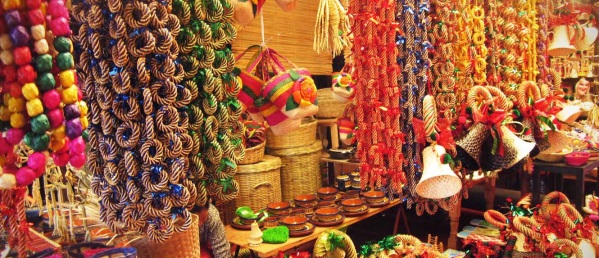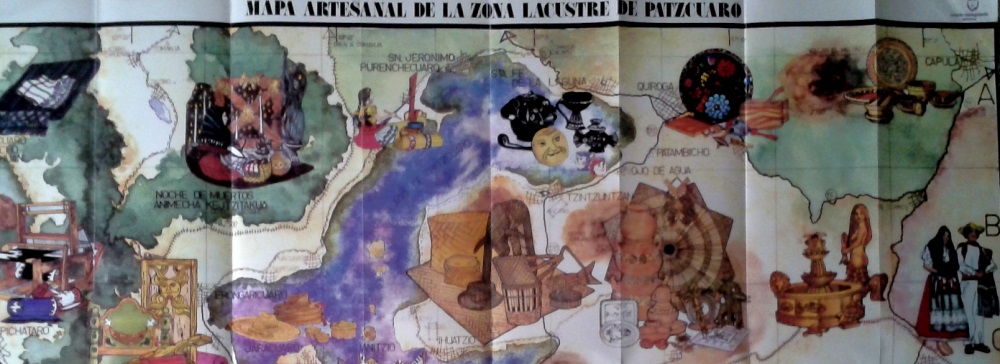Many of the arts and crafts found in Michoacán date back to pre-Columbian times, but now incorporate techniques and materials that were brought from Europe and elsewhere. Many of the introductions occurred during the time of Vasco de Quiroga (ca 1470-1565), after whom the town of Quiroga, at the eastern extremity of Lake Pátzcuaro, is named.
Visitors to Michoacán area often amazed to discover that towns even only a few kilometers apart have developed completely different handicrafts, and that all the handicraft workshops in any one town seem to focus on making precisely the same items. If one workshop in a town specializes in wooden items, all the neighboring workshops appear to do the same. Just how did these very distinctive spatial patterns come about?
The answer to the oft-asked question, “Why does each town in Michoacán have its own handicrafts?”lies in the history of this area and, in particular, of the efforts almost five hundred years ago of one Spanish priest.
Who was Vasco de Quiroga?
Vasco de Quiroga trained originally as a lawyer. He later took holy orders and arrived in the New World in 1531, already in his sixties. He gained rapid promotion and six years later was appointed Bishop of Michoacán, with the express purpose of trying to clear up the mess left by Nuño Beltrán de Guzmán’s rampage through western Mexico, and to placate the bad feelings of the indigenous Purépecha populace.
Vasco de Quiroga based his approach on the Utopian principles espoused by Thomas More. He established a series of communities in the vicinity of Lake Pátzcuaro, the heart of Purépecha country, improved security, and set up hospitals and schools serving the local people.
Agricultural improvements
Recognizing the importance of agriculture, Vasco de Quiroga introduced European implements and methods as well as new crops, including wheat and other cereals, fruits and vegetables. Perhaps his most noteworthy introduction was the banana. The first bananas to be grown anywhere in Mexico were brought by Vasco de Quiroga from Santo Domingo in the Caribbean and planted in Tzintzuntzan.
Handicrafts
Alongside religious instruction, Vasco de Quiroga organized training in arts and crafts. His efforts quickly won over many of the local people who came to acknowledge that the hostility they had experienced from their first contacts with Europeans was not typical of all the newcomers. The kindly Bishop came to be sufficiently respected by them to be awarded the honorific title of “Tata” (“Father”) Vasco.
The local indigenous Indians had already developed the skills needed for varied ceramics, wood and leather products, copper items, and woven cotton and agave fiber textiles. They also used the local lake bulrushes (tule). Vasco de Quiroga introduced new techniques which allowed the artisans to multiply their production.
To encourage specialization, and limit direct competition between villages, “Tata” Vasco allocated specific crafts to specific places, a pattern that continues to the present. The particular handicraft developed in each village also reflects the availability of local raw materials such as bulrushes needed for mats, or clay for pottery. On account of the fine quality of local clays, the making of ceramics was encouraged in the villages of Tzintzuntzan, Patamban, Santa Fe de la Laguna, Capula and Pinícuaro. Ironworking and locksmithing were introduced in San Felipe de los Hereros; quilting and embroidery in San Juan de las Colcahas, and so on.
The arts and crafts skills in the villages around Lake Pátzcuaro and elsewhere in Michoacán have been passed down to this day, becoming more finely honed with each successive generation, producing craftsmen who are among the finest in the country. They are responsible for a truly amazing variety of handicrafts, fine art and furniture items.
Among the better known places to seek out particular handicrafts are:
- Angangueo: woolen items
- Cuanajo: wooden chests and furniture
- Erongarícuaro: wooden furniture, earthenware
- Ihuatzio: petate mats
- Jarácuaro: palm hats (woven)
- Paracho: guitars and stringed instruments
- Pátzcuaro: wool, lacquer work, silver jewelry, toys, etc
- Quiroga: painted trays and bowls, leather goods, wooden toys
- Santa Fe de la Laguna: pottery
- Santa Clara del Cobre: copper items (housewares, miniatures)
- Tzintzuntzan: wood, pottery, straw decorations and toys
- Uruapan: lacquer work
- Zirahuén: wood and cloth dolls
Given this partial listing, is it any wonder that Michoacán is one of the best states in Mexico for finding interesting handicrafts? Happy shopping!
2 Responses to “The geography of the craft towns of Michoacan”
Sorry, the comment form is closed at this time.


Very interesting.
I looked up Paracho, and there are quite a few videos on youtube concerning the guitar makers of that Town.
apparently some of the craftsmen are as good as any in the world.
Here’s one of a young man in Paracho, beautifully playing a very fine sounding guitar made there.
http://www.youtube.com/watch?v=NYo9OLNLfbE&spfreload=10
Yes, absolutely, Paracho has some world-class guitar makers. Glad you enjoyed the post, and thanks for the great Youtube link!